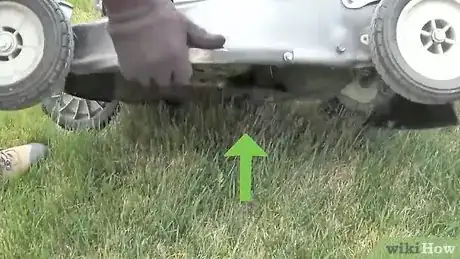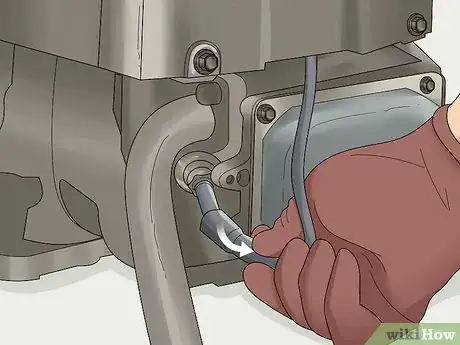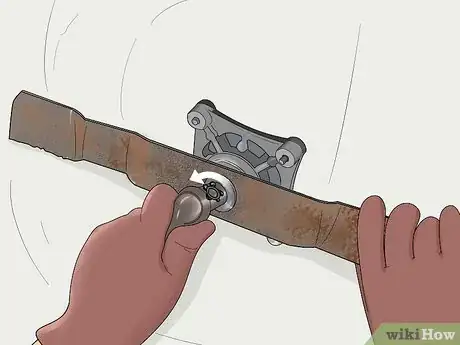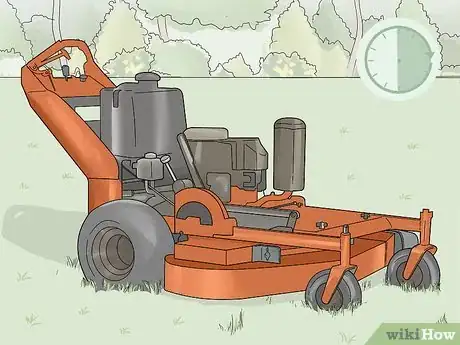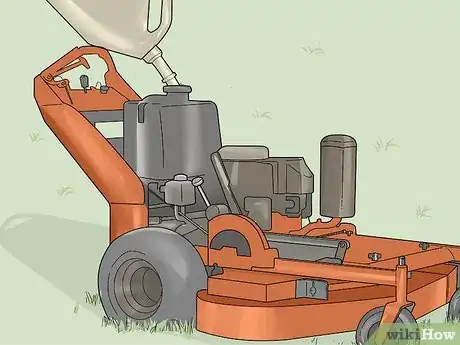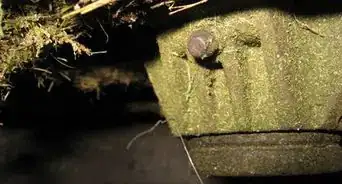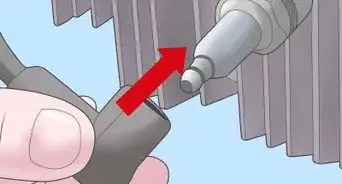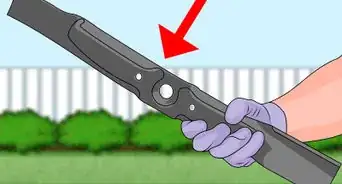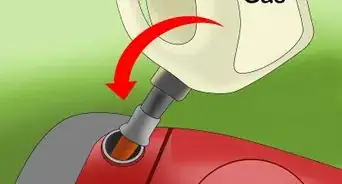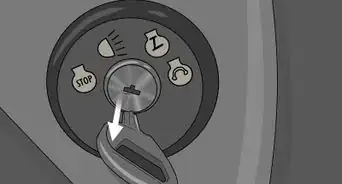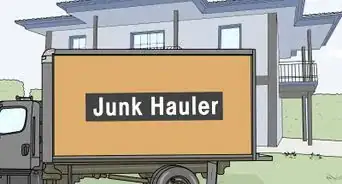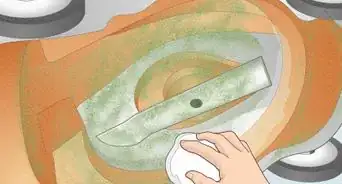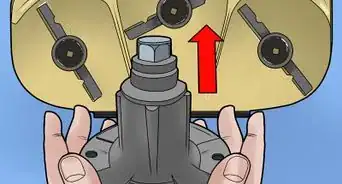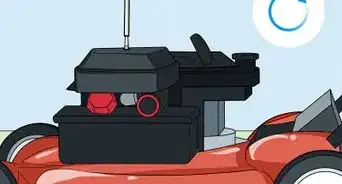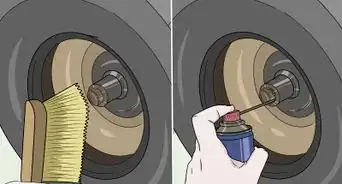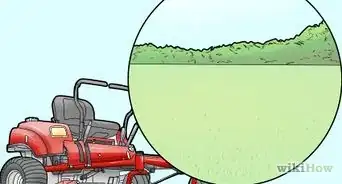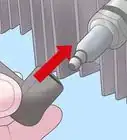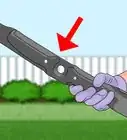This article was co-authored by Grant Wallace. Grant Wallace is a Landscaper and Owner of Grantlanta Lawn in Atlanta, Georgia. With over seven years of experience, he specializes in lawn maintenance and landscape installation. In 2012, he earned his BA from the University of West Georgia. Grant has been profiled in Shoutout Atlanta, Canvas Rebel, and Voyage ATL.
This article has been viewed 363,800 times.
If you're noticing missed patches in grass you know you mowed over, your mower just isn't cutting it any more. Blades wear out with use and need to be changed occasionally to make your mower more efficient. You'll keep your lawn healthier and you'll need to mow less frequently with sharp, clean blades. Replacing them is an easy project that won't take up much time, as long as you approach it correctly. See Step 1 for more information.
Steps
Inspecting and Removing Old Blades
-
1Lift the mower deck to expose the blade. It's important to look closely at the carburetor and the oil compartment to make sure you're not tilting the mower in such a way as to spill oil all over the engine, the grass, and yourself.[1] Generally, the safest way to do this is to tilt the mower back, toward the handle, and prop it with some kind of weight, or the help of a partner. This won't necessarily be true for all mowers, however, so use your judgment and consult the owner's manual, if necessary.
- It's also best to do this when there's no gas in the mower. Wait until you use it all up to change the blade, or you might consider draining out the gas with syphon hose. Typically, self-syphon pumps are sold at any hardware or automotive parts store. This prevents gas spillage onto the mower body.
-
2Unplug the spark plug. It's best to stay on the safe side and prevent a short-out or electrical flare-up if any oil or gas should come in contact with the spark plug. It shouldn't be a problem if you hold the mower properly, but it's still best to be on the safe side.[2]Advertisement
-
3Remove the blade mounting bolt. Use a socket wrench of the appropriate size and unbolt the mounting, while using your other hand to keep the blade from turning.[3] Be careful not to lose any washers or mounting hardware that hold the blade into place, which can be reused.
- Pay attention to the position of the blade as you're removing it. You'll mount the new one in the same orientation, usually with the sharp edge of the blade going counter-clockwise with the turning of the assembly. Again, this may not be true on all mowers, so pay attention to the way this blade is installed and install the new blade accordingly.
Installing New Blades
-
1Purchase replacement blades. Replacement blade kits for push mowers are generally only a few dollars at most home improvement or hardware stores, featuring new pre-weighted and sharpened blades, and usually replacement nuts. If your blades are particularly worn out, it's a good idea to invest in a new set.
- Some mowers feature a bottom cap on which two shorter separate blades are attached, while some newer push mowers feature a single longer blade, that looks kind of like a ruler. Tilt the mower back to inspect the blade, or talk to someone at the hardware store about the type of blade appropriate for your brand of mower. You can also check in the owner's manual, if you have it.[4]
- Alternatively, you can salvage the old blades and have them sharpened if they seem to be in decent condition. If the blades are worn out, with chips or chunks out of the metal, it's probably wise to get a new set.
-
2Mount the new blade in the appropriate direction. Line up the blades as they were lined up before and reinstall the washers and nuts, or use new washers and nuts of the appropriate size. If you have the owner's manual, there should be torque specs for tightening the nut. If not, just make sure not to over-tighten and warp the blade, which can cause vibrations in the mower.[5]
- Most blades are either specific or universal fit. Be sure you have the same length as the old blade before mounting the new one, and make sure the clearance from the lawn mower deck is the same. Tighten the new blade onto the bolts carefully, since it'll likely be much sharper than the old one.
- It's a good idea to wear thick mechanic gloves when doing the job, to keep your hands safe. It's also advisable to use a small piece of wood to stop up the blade from turning while you reinstall it. You can jam a small piece of wood between the blade and the mower deck to keep things from turning.[6]
-
3Check the blade for play. Be sure the blade is mounted correctly and has no wobble when you move it up and down, firmly. Remove any jacks or props used to hold mower in place and wait about 30-60 minutes for oil to return to motor to prevent issues or motor damage. Check the oil before use to ensure it is within the proper limits.
-
4Refill the gas tank and do a pre-check before mowing. Check the air filter to be sure that oil did not saturate the foam filter, if necessary, and reattach the spark plug wire.
- After a quick inspection, you should be able to start up your mower and start cutting that grass much more efficiently with your new blades.
Expert Q&A
-
QuestionHow often do mower blades need to be sharpened?
 Grant WallaceGrant Wallace is a Landscaper and Owner of Grantlanta Lawn in Atlanta, Georgia. With over seven years of experience, he specializes in lawn maintenance and landscape installation. In 2012, he earned his BA from the University of West Georgia. Grant has been profiled in Shoutout Atlanta, Canvas Rebel, and Voyage ATL.
Grant WallaceGrant Wallace is a Landscaper and Owner of Grantlanta Lawn in Atlanta, Georgia. With over seven years of experience, he specializes in lawn maintenance and landscape installation. In 2012, he earned his BA from the University of West Georgia. Grant has been profiled in Shoutout Atlanta, Canvas Rebel, and Voyage ATL.
Landscaper Residential homeowners who only mow their grass a couple of times a month only need to sharpen their mower blades about once or twice a year. To check your blades manually, remove the spark plug from the mower and run your finger along the blade. If it feels dull or round, it likely needs to be sharpened.
Residential homeowners who only mow their grass a couple of times a month only need to sharpen their mower blades about once or twice a year. To check your blades manually, remove the spark plug from the mower and run your finger along the blade. If it feels dull or round, it likely needs to be sharpened. -
QuestionWhat do I do for a stripped bolt?
 Community AnswerIt depends on the definition of stripped. Is it the head of the bolt or the threads? If it's the head of the bolt it may be tricky, but an EZ out and a drill tap would get the job done, or a good pair of strong vice grips and a little heat from a propane torch should also assist with removing the bolt. If it's stripped threads on the bolt then probably take the bolt to your local hardware store and get an exact copy of the bolt depending on the threads (if it's coarse, fine or whatever). I am fairly certain it's a 3/8 fine thread on lawnmower blades, though.
Community AnswerIt depends on the definition of stripped. Is it the head of the bolt or the threads? If it's the head of the bolt it may be tricky, but an EZ out and a drill tap would get the job done, or a good pair of strong vice grips and a little heat from a propane torch should also assist with removing the bolt. If it's stripped threads on the bolt then probably take the bolt to your local hardware store and get an exact copy of the bolt depending on the threads (if it's coarse, fine or whatever). I am fairly certain it's a 3/8 fine thread on lawnmower blades, though. -
QuestionWhich way should the blade be installed?
 Community AnswerThe sharp edge of the blade should be installed facing the grass. If the blades have tabs to fit into the housing, then go ahead and fit the tabs into the housing around the shaft. Always wear gloves though (preferably leather).
Community AnswerThe sharp edge of the blade should be installed facing the grass. If the blades have tabs to fit into the housing, then go ahead and fit the tabs into the housing around the shaft. Always wear gloves though (preferably leather).
Expert Interview

Thanks for reading our article! If you'd like to learn more about changing lawn mower blades, check out our in-depth interview with Grant Wallace.
References
- ↑ https://www.consumerreports.org/lawn-mowers/how-to-remove-and-replace-a-lawn-mower-blade-a1128582899/
- ↑ https://www.searspartsdirect.com/repair-guide/walk-behind-lawn-mower/how-to-replace-a-mower-blade.html
- ↑ https://www.youtube.com/watch?v=s4V8NlseeGI
- ↑ http://www.troybilt.com/webapp/wcs/stores/servlet/KnowledgeCenterArticleView?storeId=10001&catalogId=14102&pageName=en_US/knowledgeCenter/knowledgeCenterArticles/HowtoChangetheBladeonaTroyBiltWalkBehindMower.html
- ↑ https://www.consumerreports.org/lawn-mowers/how-to-remove-and-replace-a-lawn-mower-blade-a1128582899/
- ↑ https://www.searspartsdirect.com/repair-guide/walk-behind-lawn-mower/how-to-replace-a-mower-blade.html
- Videos provided by iScaper1
About This Article
Before you can change a lawn mower blade, make sure there's no gas in the mower and disconnect the spark plugs, then lift the deck of the mower to expose the blade. Next, use a wrench to loosen the mounting bolt holding the blade in place to remove it. If your old blades are chipped and worn out, replace them with a new set, then check they're in place correctly by making sure they don't wiggle up and down. Finally, refill the gas tank and reconnect your spark plugs to get mowing again. To learn how to sharpen your old blades, read on!
